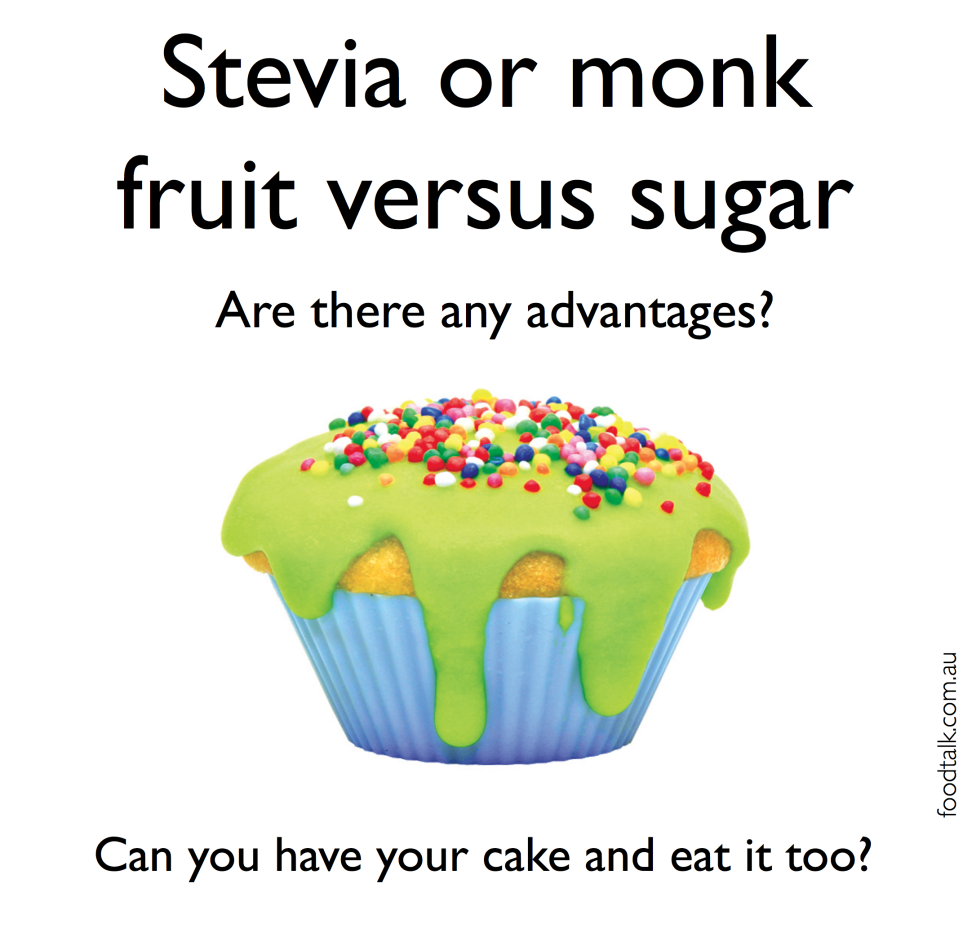Can you have your cake and eat it too?
If you bake a cake with one of the new intense sugar substitutes based on stevia or monk fruit, how much advantage will you get?
Because stevia (or more correctly steviol glycosides) and monk fruit extracts are so intensely sweet, it is rare to see either stevia or monk fruit sold in a pure form. Most often they are blended with a sugar alcohol carrier such as erythritol, maltitol or xylitol (my calculations are based on these blends) but sometimes they are blended with starch or white sugar as well.
I did a few calculations based on a simple iced banana cake recipe to see whether it is worth the switch from regular sugar to either monk fruit or stevia baking sweeteners.
The results look promising on paper but as the old saying goes "the proof of the pudding (in this case, cake) is in the eating". I have not baked a cake with these sweeteners yet. Have you? I’d really like to find out what you think before I do.
The advantages:
- Almost 50% less carbohydrate and no added sugars which is great for anyone with diabetes or high blood triglycerides.
- Fewer calories for the same serve size. For this basic cake recipe, at least 25% fewer kilojoules per slice which is great for anyone who enjoys cake but wants to stay in shape.
Let’s be clear. Switching the sweetener from cane sugar to monk fruit or stevia doesn’t turn a cake into a health food. Cakes are not the healthiest food around when made with white flour but if you are eat cake often, anything to reduce the total kilojoules without skimping on serve size and taste is an advantage. If you rarely eat cake I would not worry about making the switch.
The warning:
The majority of baking sweeteners contain sugar alcohols and unfortunately sugar alcohols have a laxative effect.
If you have large serves or binge on any foods made with intense sweeteners that contain these types of ingredients, you may get nausea, watery bowel motions, bad wind and colic. They can worsen irritable bowel symptoms. Xylitol and maltitol are worse than erythritol for bringing on these gastrointestinal side effects.
Now for the number crunching:
My calculations are based on a simple banana cake recipe and icing that yields 10 slices.
- Original ingredients for the Banana Cake: bananas, caster sugar, eggs, flour, butter.
- Icing: Cream cheese, icing sugar, orange juice
The recipe was modified by replacing both caster sugar and icing sugar with either a monk fruit blend or a stevia blend.
To slash the kilojoules (calories) further, replace the cream cheese icing with glace icing which means more monk fruit blend or stevia blend. The change in composition is shown in brackets in the table.
Compositions:
| Composition of one slice of about 115 g | Original recipe with cream cheese icing | Made with Monk fruit baking and icing sweeteners with cream cheese icing | Made with Steviol glycoside baking and icing sweeteners with cream cheese icing |
| energy per slice (kJ) | 1340 (or 1330 with glace icing) | 1030 (or 870 with glace icing) | 1000 (or 830 with glace icing) |
| protein (g) | 5 (4) | 5 (4) | 5 (4) |
| fat (g) | 12 (8) | 12 (8) | 12 (8) |
| carbohydrate (g) | 47 (57) | 25 | 24 |
| added sugars (g) | 23 (33) | - | - |
Do you use stevia or monk fruit at home?
I am keen to hear of your experience over at my FaceBook page.
All content here at foodtalk is written without external sponsorship, funding or industry influence.
I am proud that I can deliver you independent, untainted, original content. This is a very rare commodity in the online world!
